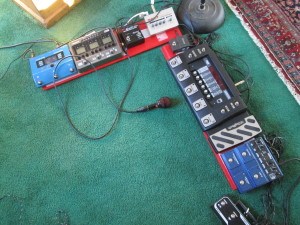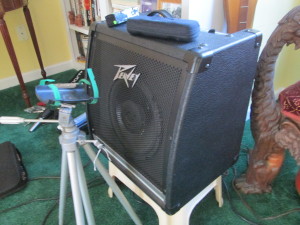
Backing Up the Hardware
As my recent posts describe, I’ve been re-configuring my rig lately. At this point it’s pretty stable, but while I was messing with it I discovered a few problem pieces in my kit. My ART MP tube preamp went flaky, and I pulled it from the rig. (I probably won’t replace it. The rig seems to work pretty well without it.)

I also had what appeared to be a problem or two with my RP500. I say “appeared” because the problem involved shaky output levels, and the ART Tube MP, not the 500, might have been the source of the problem. On top of all that, my Audix Fireball mic went belly up. The Fireball is 10 years old, and when I sent it to Audix, they advised me that a large section of the foam windscreen liner had rotted away, in addition to issues like the element coming unscrewed from the body. Yuck. Refurbishing the mic cost $35 with shipping and handling, not bad for a 10-year expense. But the problems with the RP500 and the Fireball, the two core elements of my kit, made me realize that it was time to get backups.
I own a lot of Digitech RPs, and of course operating one RP is a lot like operating another, so they’re all backups for each other. But I am getting more and more enamored of all the footswitches on the RP500, which let you do amazing things in performance. I’ve just retooled the DIRROOM patch from my RP500 patch set, for example. The original version just had a direct amp model and a room reverb. Now I’ve added a big distortion, a delay, and a flanger, all of which are under direct footswitch control on the RP500. I turn those FX off in the default setup for the patch. At any time that the patch is active, I can hit a switch or two and turn a nice, clean room sound into a big, distorted electronic tone. It’s like having a pedalboard that’s instantly re-configured and customized for every song.
In other words, all the RPs sound great, but the 500 is the one that lets you do the most big changes to your sound most easily and quickly. So all things considered, the 500 is the one I want to see at my feet when I look down.
When my RP500 started acting flaky, I did a few minor repair-and-maintain kinds of things. These seemed to produce the desired effect, but how can anyone be sure that their rig will work every time they take it out? I realized that I need a backup against the day when my first RP500 goes down and stays down. So I went to guitarcenter.com, where I found an RP500 in 4-star condition (later described to me by a salesperson as “dirty, but otherwise good”) for $129, and I bought it for $149 with taxes and shipping included. When it arrived the next day, I cleaned it up, did a factory reset, and loaded it with my latest RP500 personal patchset.

And while my Fireball mic was being repaired by Audix, I ordered a new Fireball V. I considered buying a used one, but the only used Fireball V I saw out there was priced at $90 and looked like it had been dragged behind a car over 50 miles of bad road. When a new one goes for $129, there’s no point in buying something heavily used and abused for a mere 25% discount.
So now I’m all backed up on the gear side, which is great because I am really enjoying the sounds this rig makes. The RP500 and Zoom G3 sound terrific together, and I can combine and recombine them instantly in all sorts of ways. Stay tuned for a couple of full-length songs that I recorded last night with this setup.
Tags In
Related Posts
Leave a Reply
You must be logged in to post a comment.
WHAT’S NEW
Categories
- Audio/Video
- Blog
- Blue Future
- Digitech RP Tricks and Tips
- Discography, CDs, Projects, Info, Notes
- Featured Video
- For the Beginner
- Gallery
- Hunter's Effects
- Hunter's Music
- Huntersounds for Fender Mustang
- Meet the Pros
- More Video
- MPH: Maw/Preston/Hunter
- My Three Big Contributions
- Player's Resources
- Pro Tips & Techniques
- Recommended Artists & Recordings
- Recommended Gear
- Recorded Performances
- Reviews, Interviews, Testimonials
- The Lucky One
- Uncategorized
- Upcoming Performances
- Zoom G3 Tips and Tricks